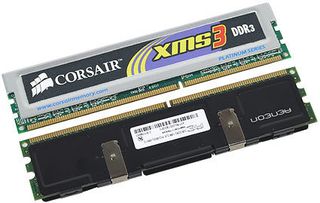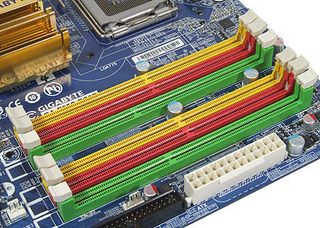Intel Intros 3-Series Chipsets with FSB1333 and DDR3
Performance: Not Yet Exciting
We've collected benchmark numbers for DDR2 and DDR3 memory at various popular speeds and timings. As you can see, DDR3 needs a noticeable clock speed upgrade until it will outperform DDR2. As you can see from the second graph, we are sure that AMD will never transition to DDR3 memory until it hasn't reached at least DDR3-1333 speed. On the one hand, DDR3 will not be mainstream before mid-2008; on the other hand the integrated memory controller of the Athlon 64 X2 processors (and the Phenom processor family) is more sensitive to latency changes than the Intel memory controller. Intel has the advantage of having the more efficient cache architecture, which levels performance differences on the memory side very efficiently.


DDR3 DImms: Same Pin Count, Different Layout

The pin count for DDR2 and DDR3 memory modules is identical, but the notch was repositioned for DDR3 hardware, because the memory is not pin-compatible and DDR3 runs at a lower voltage. DDR3 is supported at 800, 1066 and 1333 speeds, while DDR2 support stops at DDR2-800. All memory at faster DDR2 speeds may work with these chipsets (it often depends on the combination of memory and a compatible motherboard), but it has never been specified. This can be considered normal if you remember the popularity of enthusiast DDR memory at up to DDR600 speeds, although JEDEC only provided standards for DDR400.

Although the pin count hasn't changed, the position of the notch was altered to tell DDR2 and DDR3 memory apart.
Stay on the Cutting Edge
Join the experts who read Tom's Hardware for the inside track on enthusiast PC tech news — and have for over 25 years. We'll send breaking news and in-depth reviews of CPUs, GPUs, AI, maker hardware and more straight to your inbox.
Current page: Performance: Not Yet Exciting
Prev Page DDR3 Features Next Page First DDR3 DImms: Corsair CM3X1024-1066C7Most Popular

